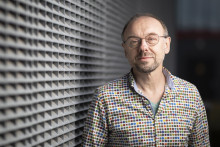In our country, we have little respect for famous Dutch scientists. Think about Hendrik Casimir, who was an eminent 20th century Dutch physicist. Near Zwolle, there is a dirt track bearing his name: the Professor Casimirweg. A dirt track! I discovered this when I once cycled in a straight line (or as straight as possible) from Enschede to Nuenen and I ended up crossing over it.
I believed this for a long time, but is all of the story true? Yes, I did take that bike ride. And you may have to look hard, but Zwolle is roughly in line with the Enschede to Nuenen route, and Hendrik Casimir was a famous physicist. Our respect for famous Dutch scientists does seem to have diminished recently, but what possessed the former municipality of Eibergen (because it was them who were responsible for the deed) to name a dirt track after Casimir?
I took some time to look into this. The word ‘dirt track’ was specifically chosen to strengthen the meaning behind my story. I could also have called it a ‘quiet country road’, which would have sounded very different. And anyway, who is this Professor Casimir? I only know of one, and that is Hendrik the physicist. His story lives within my bookcase, as part of my book bubble. In his autobiography Haphazard Reality – Half a Century of Science (Het toeval van de werkelijkheid), he doesn’t even mention Eibergen, Groenlo or Zwolle. So what does Wikipedia say then? Also nothing. But hey, Hendrik's father Rommert was a professor as well, in pedagogy. It’s fair to say that I’m less familiar with pedagogy than physics, but Rommert also appears to be well-known enough to warrant his own Wikipedia page. ‘He spent the famine struck winter of 1944-45 in his country house of De Holterhoek near Groenlo. There, he taught students from closed minor seminaries, who were in hiding, mainly farmer's sons...' So there you go, perhaps the riddle is solved, because the hamlet of De Holterhoek borders the hamlet of Zwolle. Rommert did good work helping people who were hiding out in this remote corner of the Achterhoek. At the time, the road ran – and still does run – right past the house; the 67-year-old white-bearded scholar must have been seen walking there regularly. The notion of him walking is from my imagination, but there are eyewitness accounts of that white beard. It’s possible that people in the region spoke with awe of 'Professor Casimir' and certainly not of 'Rommert'. So naming that road after him now seems to be a respectful gesture, and one which exonerates the former municipality of Eibergen. And now perhaps I’ll have to change my story.
Back to the Minister. I would actually make the somewhat bold assertion that when we use the words ‘fact’ or ‘truth’, we always mean a description resulting from a complex mishmash of – hold tight, it’s a long list! – prior knowledge, prejudices, preferences, opinions, goals, hopes, models, hypotheses, observations, analyses, self-criticism and more. Good science is all about making these things explicit and removing as much subjectivity as possible. A fact, however, does still remain a provisional description and therefore open to vulnerabilities, while the truth is something we are perpetually moving towards. The brilliant thing is that we, as scientists, can disagree over this and yet still continue to make progress. Let's make this a great academic year!







